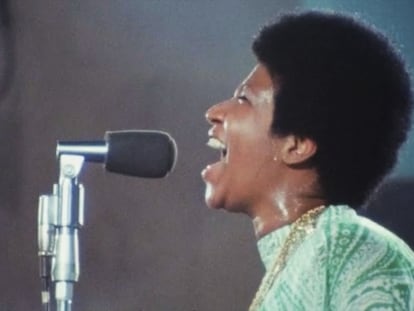The Blues Brothers: How two white comedians (who couldn’t play instruments) saved a Black music industry
The book ‘The Blues Brothers: An Epic Friendship, the Rise of Improv and the Making of an American Film Classic’ reviews the rise to fame, and sudden end, of John Belushi and Dan Aykroyd

In 1979, Aretha Franklin released an album that stalled at number 146 on the charts in the United States. That same year, Ray Charles had to settle for playing in small venues or café-theaters. The industry wanted disco music, and even The Rolling Stones and Rod Stewart were being encouraged to dance to it.
But suddenly, two white comedians arrived on the scene, dressed in black blazers and wearing sunglasses: John Belushi and fellow screenwriter Dan Aykroyd. Although they didn’t even know how to play soul music particularly well, in 1980 the duo was determined to return the throne to the African American stars who deserved another dance. And they did it with one of the most unexpected comedies in cinema. In the process, they would save the blues. They portrayed the characters Jake and Elwood Blues, known as “the Blues Brothers.”
“There was Van Halen, Kiss, Pink Floyd, Led Zeppelin… there was no room for Aretha [Franklin] and James Brown to do big shows. But, of course, let’s not forget that the film was basically made by three white men, including director John Landis. They set out to save all these Black legends. And the only reason they let them do it was because John Belushi was seen as a giant at the time,” explains American journalist and writer Daniel de Visé. He’s the author of a recently-published book on the subject, The Blues Brothers: An Epic Friendship, the Rise of Improv and the Making of an American Film Classic. The 400-page volume reviews the dizzying career and friendship of Belushi and Aykroyd, up until their success with the film. Shortly after that success, they would go their separate ways.
“It was strange that two television stars with no apparent musical abilities reinvented themselves as the singers of a rhythm and blues band, recorded an album that was among the best-sellers, and even went on tour. There were no precedents. They were no better singers than me,” the writer highlights. He’s also the author of King of the Blues: The Rise and Reign of B.B. King (2021), the biography that gave him the idea to write his latest work.
“When I saw the Blues Brothers on television for the first time, back in 1978, I didn’t know what was going on. They arrived in Europe in the form of a film, but in the United States, they were presented as a kind of five-minute sketch on Saturday Night Live (SNL). We didn’t know if they were real singers or characters, if it was humor or music,” De Visé recalls, in a video call with EL PAÍS. To delve into the history of this phenomenon — which was filled with drugs, improvisation and rock and roll — the author conducted more than 100 hours of interviews, including with Aykroyd and Landis.
It started out almost as a joke. Belushi had become famous by imitating Joe Cocker and practicing samurai moves in Studio 8H at Rockefeller Center, where SNL is still filmed today. But the two friends — experts in comedy improvisation and co-workers on a program that revolutionized television — had always dreamed of performing as a band in smoky clubs.
One day, their love for music — and for messing around with it — went one step further. They decided to create the Blues Brothers, although they had no expectation that they would end up on the air. It was just improv: by playing with the band, they wanted to encourage and warm up the audience of the TV program. They simply wanted the spectators to clap louder. Aykroyd picked up the harmonica and Belushi began to spin around. “I didn’t know anything about harmonica tones. It was something totally incredible. Then, we heard Belushi sing… and it was also incredible,” the musicians who accompanied them remember in the book.
Despite their lack of musical aptitude, a few weeks after their debut on television the duo had even built a crazy story about the legend of the Blues Brothers: they were two orphans on a “mission from God” who sought to form a band to raise $5,000 to save an orphanage. This storyline ended up being a chaotic 324-page script. Eclectic, crazy and out of order, the script was a train wreck. It only got made because of the success of Animal House (1978), which was directed by Landis and starred Belushi.
Still, the film quickly turned into a classic. The work could almost be suitable for the TikTok audience today, as it’s divided into independent fragments, featuring musical performances by some of the greatest soul artists. What’s more, even the Church considers it to be a Catholic classic. The film has been recommended time and time again in the Vatican newspaper L’Osservatore Romano.
John Belushi — unrestrained and brooding due to drug consumption — died shortly after this great success, in 1982, at the age of 33. The most uncontrollable actor of his generation (and that’s saying something), he had people from the SNL team dedicated to ensuring that his difficult character didn’t get out of NBC’s hands.
One of the most important figures was — and is — Lorne Michaels, boss of the legendary program since 1975. SNL turns 50 seasons on the air in 2024. A film directed by Jason Reitman will recreate those early years.
Neither Lorne Michaels, nor anyone else, knew where Belushi’s excesses would take him, whether to a stranger’s refrigerator or to a tycoon’s party. “My whole life is being directed. They set my schedule and I have to be where they tell me,” the comedian once lamented. In his book, De Visé adds: “Cocaine gave him energy. The barbiturates helped him sleep. The doctor urged him to see a psychiatrist. John replied that he was too busy.”
His anger was equally excessive. And he took out his anger in the studio, particularly with the women on stage. “Women aren’t funny,” Belushi told his colleagues. He wouldn’t let women write his sketches for him: he refused to read them during rehearsals. And soon, his war against the female cast came to the forefront. De Visé has a theory that he mistreated them because he was frustrated with his wife, Judy, who “wanted to have a career as an artist, [even though] he wanted her to fulfill the traditional role of a [domestic] woman.” In any case, it would be decades until SNL experienced true equality, thanks to Tina Fey and Kristen Wiig. But respect for women just wasn’t Belushi’s thing.
De Visé believes, however, that to truly understand Belushi, it’s best to turn to his two soul mates: Dan Aykroyd, his work partner (his “office husband”) and Judy Belushi, his great love since adolescence, who later authored his biography. “They were both in charge of taking care of him, keeping him safe,” he tells EL PAIS, describing a character who never grew up and had a self-destructive streak. He often skipped job interviews for parts that he wanted to get.
“You have no idea how hard it is to be me. Everything will be so much better when I’m dead,” John once told Judy in an argument. Belushi, the boy who spent his adolescence as an athlete, abstaining from alcohol and drugs, ended up becoming a superhero, a mythological presence who saved comedy and soul music… but not himself.
Sign up for our weekly newsletter to get more English-language news coverage from EL PAÍS USA Edition
Tu suscripción se está usando en otro dispositivo
¿Quieres añadir otro usuario a tu suscripción?
Si continúas leyendo en este dispositivo, no se podrá leer en el otro.
FlechaTu suscripción se está usando en otro dispositivo y solo puedes acceder a EL PAÍS desde un dispositivo a la vez.
Si quieres compartir tu cuenta, cambia tu suscripción a la modalidad Premium, así podrás añadir otro usuario. Cada uno accederá con su propia cuenta de email, lo que os permitirá personalizar vuestra experiencia en EL PAÍS.
¿Tienes una suscripción de empresa? Accede aquí para contratar más cuentas.
En el caso de no saber quién está usando tu cuenta, te recomendamos cambiar tu contraseña aquí.
Si decides continuar compartiendo tu cuenta, este mensaje se mostrará en tu dispositivo y en el de la otra persona que está usando tu cuenta de forma indefinida, afectando a tu experiencia de lectura. Puedes consultar aquí los términos y condiciones de la suscripción digital.
More information
Archived In
Últimas noticias
Welcome to the post-religion era: The idea of Christianity as the absolute truth has become obsolete
‘I thought you would like it’: The risky sexual practice popularized by TV shows and TikTok
The digitalization of tourism: ‘They promise experiences and gave us the worst possible one’
Mexican peso defies uncertainty with forecasts of a new period of stability in 2026
Most viewed
- Sinaloa Cartel war is taking its toll on Los Chapitos
- Reinhard Genzel, Nobel laureate in physics: ‘One-minute videos will never give you the truth’
- Oona Chaplin: ‘I told James Cameron that I was living in a treehouse and starting a permaculture project with a friend’
- Why the price of coffee has skyrocketed: from Brazilian plantations to specialty coffee houses
- Silver prices are going crazy: This is what’s fueling the rally










































